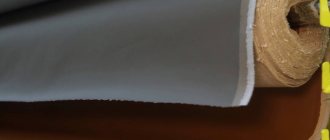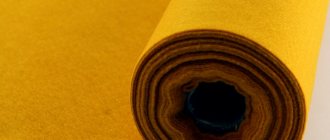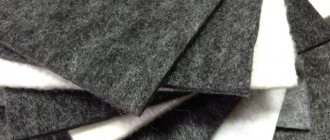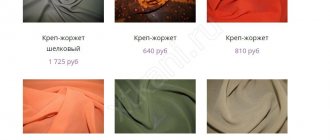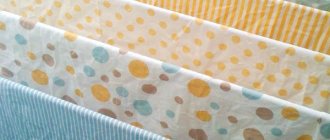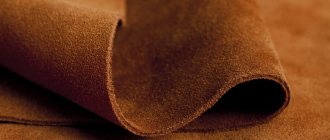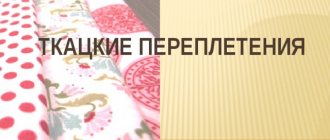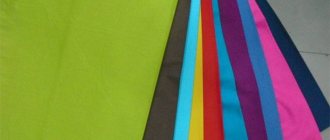Satori fabric was developed in Japan specifically for sewing workwear for medical workers. Today it is produced in some countries of Europe, the CIS and Russia. This is a unique material with all the necessary properties that make wearing such things comfortable and practical. In this article we explain in detail what satori fabric is, what it is made from and why it is popular in medicine.
Fabric Features
The main requirements for clothing in which medical workers actively work from morning to evening are convenience and safety. Next, we will discuss the characteristics of satori fabric, which accurately describe the properties and characteristics of matter.
- The plasticity of the fabric does not hinder movement.
- Durability and resistance to abrasion and wear.
- Does not become covered with pellets.
- The outer polyester layer of fabric repels any dirt and prevents infection.
- Sterilization of clothing in an autoclave is acceptable.
- With white items, you can safely use bleaching bleach.
- Colored fabrics retain their brightness for a long time even after numerous washes.
- Complies with GOST 9895-88, 24760-81 and EN13795-1-2011.
Scope of application
Durability and wearing comfort make the material convenient for sewing workwear. It has found the greatest application among medical workers. It is used to make gowns, surgical suits, and medical caps.
Uniforms are made from cloth for catering staff - cooks, waiters, dishwashers. Durability and resistance to stains make it possible to sew clothes from the fabric for employees of cleaning services and beauty salons.
When purchasing material, you should study the information on the label. The mold, made in Japan, is of the highest quality and will last a long time. But it also costs more.
You should also examine the percentage of cotton and synthetic fiber. The more natural threads, the denser the material, the better it allows air to pass through. A higher synthetic content increases strength and stretchability.
When choosing a suit for a medical worker, preference should be given to the appearance of the material. Solid pastel colors are recommended.
The fabric must contain at least 50% cotton, as you will have to spend a lot of time in it.
The uniform of a catering worker or beauty salon technician should be as resistant to dirt as possible.
Men's and women's workwear for health workers made of the following materials:
Composition and production
The composition of satori fabric is mixed and includes 50% cotton and 50% polyester. It is woven in such a way that the outer side is polyester and the inner side is cotton. The manufacturer took care of comfortable wear and pleasant sensations from things, and at the same time, the practicality of the front side. Thanks to the twill weave, satori is very durable, smooth and pleasant to the touch.
Satori is painted in a variety of colors. For doctors, these are usually white, light blue, turquoise and lilac. Children's doctors prefer uniforms with images of cartoon characters. Thermal printing designs can be easily applied to this fabric and the embroidery looks beautiful.
Characteristics, description, composition
Satori is a fabric whose description can be compared with other twill weave fabrics by the presence of a characteristic hem. When producing it, a special type of weaving is used, in which there are cotton threads on the inner, back side, and only polyester on the outer side.
Satori fabric has a mixed composition: 50% cotton and 50% polyester. Due to the fact that the outer side is formed from polyester, it has a smoother, shiny surface and has the ability to repel dirt and water. Natural cotton fibers make the material soft and comfortable, breathable and hygroscopic.
Satori fabric has the following characteristics:
- density (in the classic composition 145 g/m2);
- hypoallergenic;
- hygroscopicity;
- resistance to paint abrasion;
- crease resistance;
- wear resistance;
- low percentage of shrinkage;
- crease resistance.
Our website contains photos and descriptions of all known types of woven fabrics, you can find them here.
Varieties of satori
Manufacturers produce satori fabric with different densities for different applications.
Software Soft fabric with a density of 130 g/m2, consisting of 60% cotton and 40% polyester.
Bamboo. Consisting of cotton and bamboo fibers. Density 145 g/m2.
Comfort. It is 100% cotton, very soft fabric with a weight of 165 g/2.
Light. The thinnest variety is satori light, with a density of 110 to 140 g/m2. Despite its thinness, the fabric is still very durable and wear-resistant.
Satori Satin. The densest satori fabric with a density of 190 g/m2. It has a satin weave, smooth and shiny surface. Consists of cotton and polyester in equal proportions.
Light stretch. Fabric with increased elasticity of fibers, thin and light.
Extrastretch. New generation fabric. It has high elasticity, does not deform in areas of greater stretch, fits tightly to the figure and does not hinder movement. Made from 60% cotton, 35% polyester and 5% lycra.
What are the varieties?
The classic version of satori contains equal amounts of cotton and polyester. Other types differ not only in composition, but also in density and type of fiber weave.
There are such varieties:
- Light. Durable, has a density of 115 g/m².
- Satin. Shiny, density – 190 g/m².
- Bamboo. Bamboo and cotton threads are intertwined, density – 145 g/m². The material is soft, environmentally friendly, with an antibacterial effect, regulates temperature - warms in the cold, cools in the heat.
- Comfort. Cotton with twill weave, density – 165 g/m². Breathable, soft.
- Software Density – 130 g/m². Cotton predominates (60%).
- Light Stretch. Stretchable and thin.
- Extrastretch. It fits snugly but doesn't interfere with movement.
- Tencel. The silky surface is ensured by the presence of polyester and viscose in the composition. The material quickly absorbs moisture.
- Twill. Soft, flexible, density – 180 g/m².
- Ultra. Density – 210 g/m². Products made from this material are suitable for long-term wear.
- Print. Printed knitwear.
Printed material is often combined with one-colored material.
The fabric is practical and comfortable to wear.
Application
What is sewn from satori besides medical uniforms? Uniforms for catering workers, hotels, cosmetologists, beauty industry workers (hairdresser, manicurist, tattoo, spa, massage). Clothing made from satori material not only provides comfort during long-term wear, but also protects against unwanted influences (contact with cream, penetration of other people's hair under clothing, blood, hair dye).
It is very important for service personnel in restaurants and cafes to look presentable and neat. Stylish aprons, shirts, skirts for waiters, chef's coats and caps are made from satori fabric.
Although this is rare these days, you can still find a kindergarten teacher and nanny in a beautiful white robe. Such clothing helps to comply with all sanitary standards and protects clothing from accidental contamination.
Cleaning companies that are popular today also use workwear made from satori fabric; in addition, they often decorate their uniforms with emblems or embroidery, which makes their company recognizable and popular.
Satori fabric composition
The material contains cotton and polyester in equal proportions. Thanks to this natural structure, clothes made from satori material are highly breathable, which ensures comfortable wearing. In addition, the fabric is very soft to the touch, the fibers have good hygroscopicity - this is all thanks to cotton threads. Polyester helps the product not to lose its shape and to be used for a long time.
The weave itself is unique, as it consists of two layers. The part of the fabric that is worn closer to the body will be made of cotton, and the front side of the garment will be made of polyester. For this reason, clothes made from satori always look smooth and shiny. Also, the fabric does not allow dirt and bacteria to linger on it, the appearance of the fabric is beautiful, and the things are quite practical.
This composition is especially important for medical workers. During working hours, they are not able to wear casual clothes, but at the same time, the medical gown must be comfortable and easy to wear. Satori copes well with this task.
Such material is produced today not only in Japan, but also in the CIS countries and the European Union. But when choosing, you should be careful and look not only at the description given by the seller, but also at the type of weave and texture of the fabric, because no one is safe from buying fakes.
Advice
Please note: depending on the purpose of using the fabric, you can choose the appropriate fabric composition. Thus, material with additional bamboo content is available for sale.
Care
Satori fabric is easy to care for. If necessary, it can withstand sterilization in an autoclave and washing at high temperatures.
If your satori items do not need intensive processing, then you can get by with a regular short cycle wash at 40 degrees. All stains can be easily washed off using any washing gel. To preserve brightness, it is recommended to wash colored items in water no hotter than 40 degrees. You can spin satori at any speed. Iron with caution, preferably with a damp iron.
Advantages and disadvantages of satori
The fabric consists of natural cotton and high-quality polyester fiber. Thanks to this, it has good performance qualities:
- strength;
- softness;
- wear resistance;
- resistance to pollution;
- hygroscopicity - the ability to absorb moisture.
The material can withstand harsh washing conditions and boiling. Almost does not wrinkle, after drying in a straightened state, the clothes do not need to be ironed. Retains color and shape for a long time.
Thanks to the natural cotton backing, satori clothes are pleasant to wear, even during daily duty. The fabric allows air to pass through well, allows the skin to breathe, and does not cause irritation.
There is no allergy to such clothes. The synthetic front side repels dust and dirt and does not get wet for a long time.
Despite all the positive properties, there is one drawback. Ordinary clothes are not sewn from satori, because they will look official, and an immediate association with a uniform arises.
The cost of a meter of fabric is 170-300 rubles. A robe costs 1,500–3,000 rubles, and a suit costs 2,500–4,000 rubles.
Reviews
Reviews of satori fabric are left by both medical workers and seamstresses who directly work with this fabric.
Inga: “At our garment factory we sew uniforms for doctors at a children’s hospital. Satori fabric for such things is the best, and not only for doctors, but also for me as a seamstress. It’s easy to work with such material: it almost doesn’t slip and doesn’t crumble when cut, doesn’t shrink during steam processing, and simply fits beautifully to any figure.”
Valery: “As a senior waiter at a large restaurant, I can responsibly declare: uniforms made from satori are the best at removing stains of any complexity. Our aprons and shirts often get dirty with fatty sauces and bright wines, and all this can be washed well with any powder.”
Katya: “I am a dentist by profession, and while working, tooth chips, particles of medicine, and sometimes even blood often get on my clothes. Therefore, it is very important to have a well-protective uniform for such work. And there is such a thing - clothes made from satori material. It does not allow even the smallest particles to pass through and is easily washed off from dirt.”
Features of care
The features of care are dictated by the profile of the health worker . Sterility requirements are imposed:
- for the clothing of doctors in surgical departments;
- obstetricians;
- pharmacists involved in the production of medicines;
- cosmetologists.
Such clothing is sterilized in an autoclave under high pressure and heated to 105°C . White clothes made from Satori fabric can be disinfected with a chlorine-containing solution without compromising its integrity. In other cases, machine washing and ironing will be sufficient.
Medical staff clothing should not be washed together with hospital linen.

